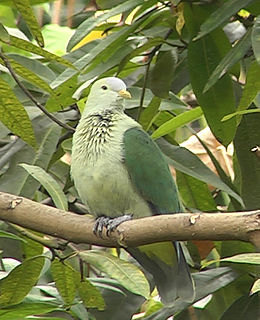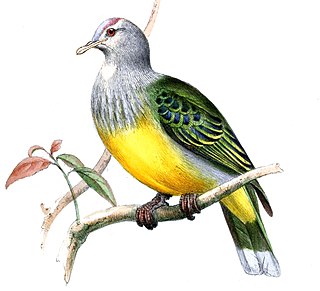
The pink-headed fruit dove also known as pink-necked fruit dove or Temminck's fruit pigeon, is a small colourful dove.

The jambu fruit dove is a smallish colourful fruit dove. It is a resident breeding species in southern Thailand, Malaysia, Brunei and the Indonesian islands of Kalimantan, Sumatra and Java.

The black-naped fruit dove, also known as the black-headed fruit dove, is a medium-sized, up to 24 cm (9.4 in) long, green fruit dove with yellowish bill and iris. The male has a pale grey head with a black nape, yellow throat, and golden yellow and pink undertail coverts. The plumage of the female and the young is entirely green.

Wallace's fruit dove is a species of bird in the pigeon family Columbidae. The name commemorates the British naturalist Alfred Russel Wallace. It is a rather large, long-tailed fruit dove with a length of 24–28 cm (9.4–11.0 in) and has been described as "one of the most beautiful" fruit doves. The forehead and crown are dull crimson, the lower face and throat are white, and the rest of the head, breast, neck, and upper back are pale bluish-grey. The wings and lower back are green and the belly is orange, separated from the chest by a white band. Both sexes look similar, but females have less extensive red on the head and a greenish tinge to their grey parts.

The orange fruit dove is a species of bird in the pigeon family Columbidae. One of the most colorful doves, the male has a golden olive head and elongated bright orange "hair-like" body feathers. The golden-olive remiges are typically covered by the long orange wing coverts when perched. The legs, bill and orbital skin are bluish-green and the iris is whitish. The female is a dark green bird with blackish tail and orange-yellow undertail coverts. The young resemble females.

The rose-crowned fruit dove, also known as pink-capped fruit dove or Swainson's fruit dove, is a medium-sized, up to 22 cm long, green fruit dove with a grey head and breast, an orange belly, whitish throat, yellow-orange iris, and greyish green bill and feet. It has a pinkish-red crown with yellow border. The Indonesian subspecies, P. r. xanthogaster, has a whitish crown and paler grey head and breast. Both sexes are similar. The young has a green-colored crown and plumage.

The Negros fruit dove is a species of bird in the pigeon and dove family, Columbidae. It is endemic to the island of Negros in the Philippines. This fruit dove is known from a single female specimen collected from the slopes of Mount Kanlaon in the northern part of the island. While it was found at a high elevation, it is suspected that the species originally lived in the lowland dipterocarp forests and was driven to higher elevations by habitat destruction. While some have suggested that the specimen is either a runt or a hybrid instead of a valid species, this is not widely accepted. The female Negros fruit dove was a small fruit dove with vivid dark green plumage and an ashy-grey forehead. It had a distinctive ring of bare yellow skin around its eye, and yellow fringes to some of its feathers gave it the appearance of having a yellow wingbar when perched. The throat was white, while the undertail and vent were yellow.

The white-headed fruit dove is a species of bird in the pigeon family Columbidae. It was described by the English ornithologist John Gould in 1856, and the specific name eugeniae honours the French empress Eugénie de Montijo. Adults of the species have white heads, a purplish-red breast patch, a grey shoulder patch, olive-green upperparts, greenish underparts with a blue tinge, and a yellowish vent. Juveniles have green heads with the white restricted to the forehead and upper throat, a much smaller grey shoulder patch, and the red breast patch restricted to the centre of the breast.

The knob-billed fruit dove is a species of bird in the family Columbidae. It is endemic to the Bismarck Archipelago.

The red-moustached fruit dove was a species of bird in the family Columbidae. It was endemic to French Polynesia. The last record was of the subspecies P. m. tristrami on Hiva Oa, in 1922. Its extinction has been attributed to predation by the introduced great horned owl, as well as by introduced rats and cats. In 1994, it was listed as an extinct species on the International Union for Conservation of Nature Red List of Endangered Species.

The yellow-breasted fruit dove locally known as balorinay is a species of bird in the family Columbidae. It is endemic to the Philippines. Its natural habitat is tropical moist lowland forest. While it is listed as least concern in IUCN, it is declining due to habitat loss, hunting and trapping for the illegal wildlife trade.

The ornate fruit dove is a species of bird in the family Columbidae. It is found in New Guinea. Its natural habitats are subtropical or tropical moist lowland forest and subtropical or tropical moist montane forest.

The Palau fruit dove is a species of bird in the family Columbidae. It is endemic to Palau and it is also Palau's national bird.

The many-colored fruit dove, known as manuma in the Samoan language, is a species of bird in the family Columbidae. It occurs on islands in the south-west Pacific Ocean where it is found in Fiji, the Samoan Islands, and Tonga. Its natural habitat is subtropical or tropical moist lowland forests. Today, most often the birds are found in Fiji and Tonga. It usually feeds high in the canopy on fruit and berries, especially banyan fig. The nest is a small platform of twigs where one white egg is laid.

The crimson-crowned fruit dove is a species of bird in the family Columbidae. It is found in American Samoa, Fiji, Marshall Islands, Niue, Samoa, Tonga, and Wallis and Futuna Islands. Its natural habitats are subtropical or tropical moist lowland forest and subtropical or tropical mangrove forest.

The grey-green fruit dove is a species of bird in the family Columbidae. It is endemic to the Society Islands in French Polynesia. Its natural habitat is subtropical or tropical moist lowland forests.

The white-bibbed fruit dove is a species of bird in the family Columbidae.

The claret-breasted fruit dove is a species of bird in the family Columbidae. It is found in the Moluccas, New Guinea and the Solomon Islands archipelago. Its natural habitat is subtropical or tropical moist lowland forests.

The fruit doves, also known as fruit pigeons, are a genus (Ptilinopus) of birds in the pigeon and dove family (Columbidae). These colourful, frugivorous doves are found in forests and woodlands in Southeast Asia and Oceania. It is a large genus with over 50 species, some threatened or already extinct.

The Raiatea fruit dove is a species of bird in the family Columbidae. It is endemic to the Society Islands in French Polynesia. Although first named to science in 1853, this fruit dove was evidently discovered 30 years earlier, by René Primevère Lesson (1794–1849), while serving as naturalist aboard La Coquille. It was formerly considered a subspecies of the grey-green fruit dove but was split as a distinct species by the IOC in 2021. Its natural habitat is subtropical or tropical moist lowland forests.






















